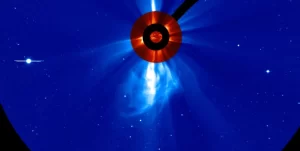Filament eruption produces large CME, slight graze possible
A solar filament eruption centered near S35E50 took place around 20:00 UTC on March 5, 2024, producing a large coronal mass ejection (CME) which is expected to slightly graze Earth late March 8. G1 – Minor geomagnetic storms are possible on March 9 due to the combined effects of a negative polarity CH HSS and this CME.

